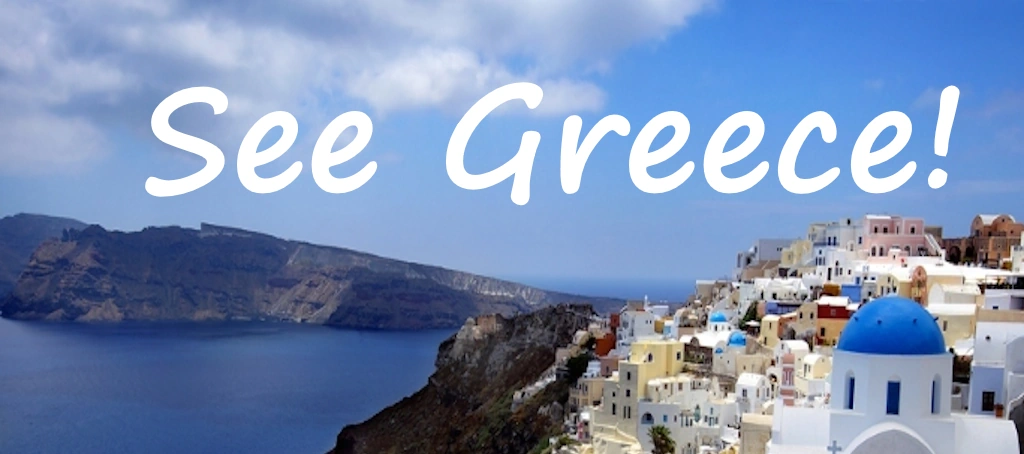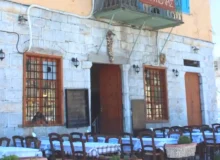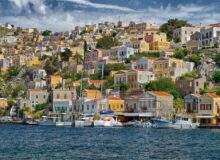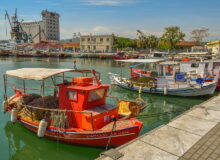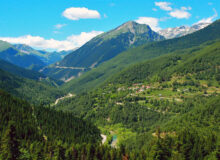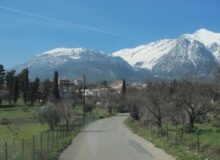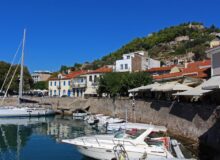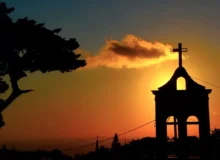Agios Nikolaos
See Greece’s guide to Agios Nikolaos on Crete with a brief history and a note of what there is to do and see there, including nearby beaches.

The port of Agios Nikolaos is one of the prettiest and most popular places on Crete. Justifiably so as it is beautifully located on the Gulf of Mirabello, retains some of its old mansion houses, has a beautiful fishing harbour and another inner harbour which is in fact a lake: Lake Voulismeni.
All these attractions, and many more in and around the town, do turn it into one of the busiest places on Crete in midsummer, yet despite all this it manages to cling onto its own character.

Agios Nikolaos: A Brief History
Oficially founded in the late 19th century, the town was named after the Byzantine church of Agios Nikolaos (Saint Nicholas) that once stood there. However, the area has ancient roots, with nearby archaeological sites such as the Minoan settlement of Lato dating back to the 8th century BCE.
The modern town grew around a deep, circular lake called Voulismeni, once believed to be bottomless and linked to ancient myths. During the Venetian and Ottoman periods, the region was sparsely populated, but after Crete’s independence in 1898 and union with Greece in 1913, Agios Nikolaos developed into a fishing village.
In the 1960s and 70s, tourism transformed the town into a popular destination, attracting artists, writers, and celebrities. Today, it serves as the capital of the Lasithi regional unit, blending traditional Cretan charm with modern amenities. Its scenic beauty, archaeological sites, and lively waterfront make it a key tourist hub in eastern Crete.
It is also still an important port, and you will find fishermen drying their nets in the harbour, and ferry boats coming in regularly from the Dodecanese, Cyclades and from Piraeus.
The Harbour at Agios Nikolaos

The harbour is lined with shops, bars, cafes and tavernas, which make full use of their setting by charging prices that are expensive by Greek standards. If you want better food and a slightly more Cretan atmosphere, forego the setting and wander into the back streets. On the south side of town is a small beach and a marina, also home to some pricey restaurants.
Near the bus station at the western end of the marina is the church of the Panagia Vrefotrofou, which dates back to the 12th century and is yet another Cretan example of the ancient and modern standing side by side.
The Bottomless Lake

The Lake that acts as the inner harbour, Lake Voulismeni, is known as the Bottomless Lake. It has very steeply sloping sides and is certainly deep for its size, but its depth has been measured at 64m (210ft), which is a long way from bottomless. It links with the outer harbour by a channel that was built between 1867 and 1871.
The Archaeological Museum
Agios Nikolaos also has an excellent Archaeological Museum, slightly out of the centre to the northwest, which is one of the highlights of the town. There are several Minoan sites for the museum to call on, and it has a good display of recovered artifacts.
One notable exhibit is the Goddess of Myrtos in Room II, found at Mochlos just outside Gournia. It is a drinking vessel made of clay and dating back to the early Minoan period. It was obviously used for fertility purposes as it has a neck and head that is clearly phallic but the vessel itself has two breasts shaped onto it.
The most unusual if unsettling exhibit is a skull which is thought to be that of an athlete as it was found intact complete with the golden laurel wreath which was traditionally given for athletics victories, and a silver coin to pay his fare to the ferryman for the journey across the River Styx to the Underworld. The skull was found near the town and can be dated by the coin to the 1st century AD.

Agios Nikolaos Beaches
The beaches around Agios Nikolaos offer a mix of golden sands, crystal-clear waters, and stunning landscapes, catering to both relaxation and adventure seekers. The most famous is Ammoudi Beach, right in the town center, with soft sand and shallow waters, ideal for families. Nearby, Kitroplatia Beach is another convenient option, featuring tamarisk trees for shade and a lively seaside atmosphere.
Just a 5-minute drive south is Almyros Beach, a long stretch of golden sand backed by freshwater springs, creating a unique mix of cool and warm waters. Along the coast to the north, Ammos Beach in Elounda offers shallow, turquoise waters with views of Spinalonga Island.
For a more secluded experience, Voulisma Beach (Golden Beach) in Istro, about 15 minutes south of Agios Nikolaos, dazzles with its fine white sand and blue waters, often ranked among Crete’s best.
For adventure, Karavostasi Beach, a hidden pebble cove near Plaka, offers tranquility and stunning Spinalonga views, while Ligaria Beach, with its dramatic cliffs, is perfect for diving.
